Afghan_Kush_2
SRR 3294441
General Information
- Accession Date
- February 7, 2016
- Reported Plant Sex
- Male
- Report Type
- Whole-Genome Sequencing
The strain rarity visualization shows how distant the strain is from the other cultivars in the Kannapedia database. The y-axis represents genetic distance, getting farther as you go up. The width of the visualization at any position along the y-axis shows how many strains there are in the database at that genetic distance. So, a common strain will have a more bottom-heavy shape, while uncommon and rare cultivars will have a visualization that is generally shifted towards the top.
Chemical Information
Cannabinoid and terpenoid information provided by the grower.
Cannabinoids
No information provided.
Terpenoids
No information provided.
Genetic Information
- Plant Type
- Unknown
File Downloads
The bell curve in the heterozygosity visualization shows the distribution of heterozygosity levels for cannabis cultivars in the Kannapedia database. The green line shows where this particular strain fits within the distribution. Heterozygosity is associated with heterosis (aka hybrid vigor) but also leads to the production of more variable offspring. When plants have two genetically different parents, heterozygosity levels will be higher than if it has been inbred or backcrossed repeatedly.
The ratio of reads mapped to Y-contigs to reads mapped to the whole Cannabis genome (Y-ratios) has been demonstrated to be strongly correlated with plant sex typing. This plot shows the distribution of Y-ratios for all samples in our database which were sequenced with the same method (panel or WGS) as this sample and where this sample falls in the distribution.
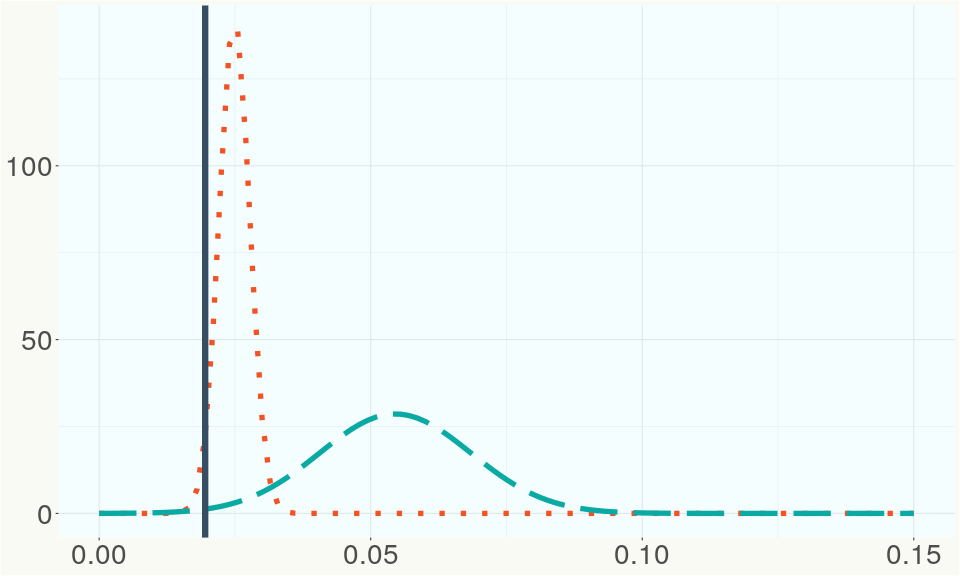
This chart represents the Illumina sequence coverage over the Bt/Bd allele. These are the three regions in the cannabis genome that impact THCA, CBDA, CBGA production. Coverage over the Active CBDAS gene is highly correlated with Type II and Type III plants as described by Etienne de Meijer. Coverage over the THCA gene is highly correlated with Type I and Type II plants but is anti-correlated with Type III plants. Type I plants require coverage over the inactive CBDA loci and no coverage over the Active CBDA gene. Lack of coverage over the Active CBDA and Active THCA allele are presumed to be Type IV plants (CBGA dominant). While deletions of entire THCAS and CBDAS genes are the most common Bt:Bd alleles observed, it is possible to have plants with these genes where functional expression of the enzyme is disrupted by deactivating point mutations (Kojoma et al. 2006).
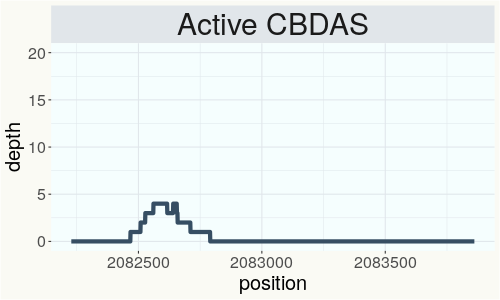
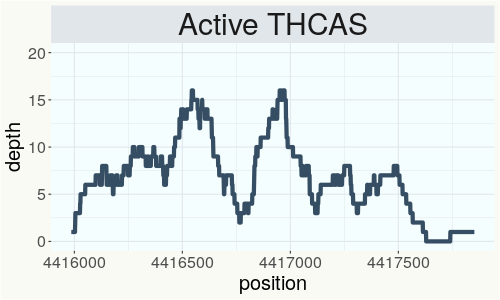
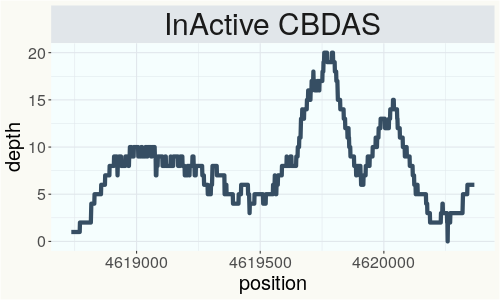
This chart represents the Illumina sequence coverage over the CBCA synthase gene.
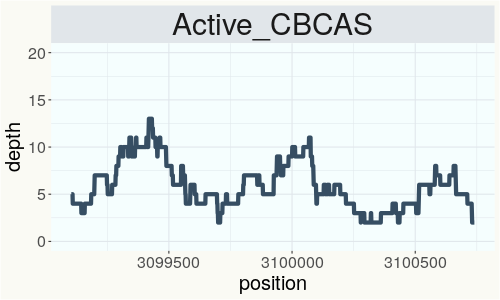
Variants (THCAS, CBDAS, and CBCAS)
No variants to report
Variants (Select Genes of Interest)
| PHL-2 | c.1540A>G | p.Thr514Ala | missense variant | moderate | contig2621 | 340818 | A/G | |
| FAD2-2 | c.172G>T | p.Asp58Tyr | missense variant | moderate | contig83 | 1803197 | C/A |
|
| FAD2-2 | c.64G>T | p.Ala22Ser | missense variant | moderate | contig83 | 1803305 | C/A |
|
| aPT1 | c.629C>T | p.Thr210Ile | missense variant | moderate | contig121 | 2840237 | C/T | |
| HDS-2 |
c.82_93delGT |
p.Val28_Thr3 |
conservative inframe deletion | moderate | contig95 | 1989748 |
CGTAACCGGAAC |
|
| HDS-2 | c.127T>G | p.Ser43Ala | missense variant | moderate | contig95 | 1989794 | T/G |
|
| PIE1-2 | c.5932A>G | p.Ile1978Val | missense variant | moderate | contig1460 | 1185552 | T/C | |
| GGR | c.679G>A | p.Glu227Lys | missense variant | moderate | contig2282 | 549671 | G/A |
|
| GGR | c.704A>T | p.His235Leu | missense variant | moderate | contig2282 | 549696 | A/T |
|
Nearest genetic relatives (All Samples)
- 0.050 UC 167 (SRR14419585)
- 0.068 Blue Dream (RSP11017)
- 0.079 (SRR3294430)
- 0.083 UC 27 (SRR14419817)
- 0.083 B52 (SRR14708255)
- 0.083 Ruderalis Indica (SRR14708267)
- 0.086 UC 21 (SRR14419861)
- 0.088 Electra (RSP11366)
- 0.089 UC 445 (SRR14419766)
- 0.091 UC 32 (SRR14419761)
- 0.091 R1in136 (SRR14708237)
- 0.095 Blue Dream (RSP11007)
- 0.096 Rest (RSP11377)
- 0.097 UC 46 (SRR14419703)
- 0.097 UC 70 (SRR14419679)
- 0.100 UC 168 (SRR14419584)
- 0.100 Alpine Rocket (SRR14708266)
- 0.103 (SRR3294451)
- 0.106 Lemon OG Haze (RSP11977)
- 0.109 Triangle Kush x Square Wave BX (RSP12100)
Most genetically distant strains (All Samples)
- 0.413 80E (RSP11213)
- 0.407 JL 4th Gen 2 (RSP11194)
- 0.400 80E (RSP11211)
- 0.396 80E (RSP11212)
- 0.395 Feral (RSP10890)
- 0.376 Feral (RSP10891)
- 0.375 JL 3rd Gen Mother (RSP11214)
- 0.368 Carmaleonte (RSP11207)
- 0.367 JL 4th Gen 5 (RSP11199)
- 0.358 JL 3rd Gen Father (RSP11196)
- 0.355 Fedora 17 (RSP10661)
- 0.352 JL 4th Gen 1 (RSP11193)
- 0.351 Northern Lights (RSP11501)
- 0.349 Diana (RSP10235)
- 0.346 Carmagnola USO 31 (RSP11204)
- 0.344 Feral (RSP11205)
- 0.343 Fedora 17 (RSP11203)
- 0.343 Tiger Tail 30 (RSP11484)
- 0.342 Tiborszallasie (RSP11210)
- 0.342 Feral (RSP11206)
Nearest genetic relative in Phylos dataset
- Overlapping SNPs:
- 6
- Concordance:
- 6
Nearest genetic relative in Lynch dataset
- Overlapping SNPs:
- 3
- Concordance:
- 3
Blockchain Registration Information
- SHASUM Hash
-
f0a7eb8ec92b2bd9e7a9ecc71daa2b8e 715c014b24327853 bb3acc1135a824cf